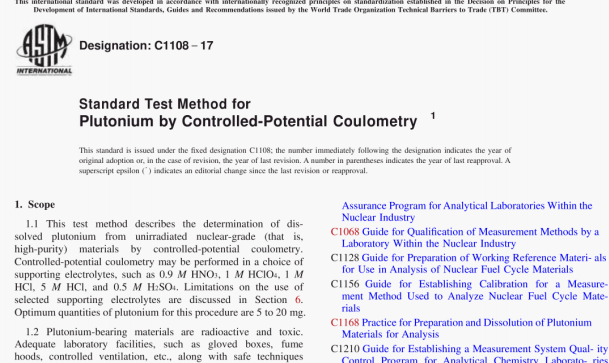ASTM C1108:17 pdf download.Standard Test Method for Plutonium by Controlled-Potential Coulometry.
6.4 Iron—In 0.5 M H4S04 supporting electrolyte, iron is reduced and oxidized at essentially the same formal redox potentials as the Pu(III)-Pu(IV) couple and thus constitutes a direct interference. Iron must be removed by prior separation, or the effect of its presence must be corrected by a separate measurement of the iron concentration in the sample solution. In 1 M HCI, I M HNO3, or 1 M HC1O4, iron interferes to a lesser extent. The effect of iron in these supporting electrolytes may be minimized by the choice of redox potentials, by a secondary titration (10), or by electrochemical correction (12, 13).
6.5 Nitrites — – Nitrites are clectrochemically active; therefore, saturated sulfamic acid solution should he added to the electrolyte in the cell to destroy any interfering nitrites when a nitric acid supporting electrolyte is used.
6.6 Suftite— Because of the complexing action of sulfate on Pu(IV) and the resultant shift in the redox potential of the Pu(11I)-Pu(IV) couple, that is, the formal potential, only small amounts of sulfate are tolerable in HNO3, HCI, and HCIO4 electrolytes. When using these supporting electrolytes, specimens should he fumed to dryness to assure adequate removal of excess sulfate (see 12.3.1.3). For aliquots of dissolved MOX fuels that have not been purified by anion exchange to remove the uranium, the sulfate concentration after fuming will still be elevated. A formal potential should be measured for the specific U:Pu ratio and used in the calculations for these aliquots.
NoTk 1—Interference from a sulfate concentraLion of >0.004 M in I M HCIO4 has been reported (10).
6.7 Fluoride—Free fluoride cannot be tolerated and must be removed from the specimen. Evaporation of the specimen in HNO3 to a low volume and fuming with H2S04 are effective in removing fluoride.
6.8 Oxygen—In H2S04 supporting electrolyte, oxygen interferes and must be removed. In HNO3. HC1, and HCIO4 supporting electrolytes, oxygen may be an interference, depending upon experimental conditions. Purging the specimen with high-purity argon prior to and during the coulometric determination is recommended for all electrolytes.
7. Apparatus
7. 1 controlled-Potential C’oulomeier—A coulometer with the tollowing specifications is recommended to achieve highly precise and accurate results. (Room temperature stability of
6 lC is recommended to ensure optimum instrument performance. Instruments with smaller output current or smaller voltage span may be satisfactory.)
7.3 cell Assembly—The success of controlled-potential coulometnc methods is strongly dependent on the design of the cell. The cell dimensions, electrode area, spacing, and stirring rate are important parameters in a design that will minimize the time required for titration. The following components are required for the recommended cell assembly (Fig. 1).
ASTM C1108:17 pdf download
